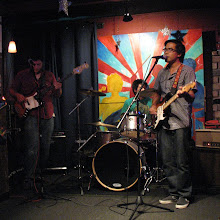Ah... it's my favorite time of the recording process: guitar overdubs. Of course it would be, being I am a guitarist. For the past couple days, whenever there is a time when it is quiet in the house, I drag Katie '66 (aka my guitar amp) into the living room and rig up a couple mics and let 'er rip. I have the make sure no one is home to minimize extraneous noises on the recording, and since tube guitar amps like my own sound best when turned up to a pretty good click, it might be too loud for bystanders. Wear earplugs folks.
The basic rhythm track was recorded in stereo using two Shure SM57s on Katie '66. I rolled some of the treble off to have it sit further back in the mix.
Another view of the stereo miking setup.
I removed the grille cloth so I can accurately place the microphones, though I'm sure removing the cloth made the amp sound clearer than it normally does.
Getting A Full Rhythm Guitar Track.
Fat, thick, chunky... many words can describe the rhythm guitar sound found on many rock albums, but no matter what words that are used, modern rock guitar (even reach far back to Led Zeppelin) is often defined by a full and harmonically complex sound. There are many ways to obtain this sound, but they almost always require layering performances.
If a thick and more uniform rhythm guitar sound is needed, like that heard on hard rock, metal and punk albums, layering multiple (at least two) performances of the same chord changes played on the same guitar, amplifier, and pedals can be employed. This is the most straightforward technique, though it is important to note that you must be wary of your gain levels when doing this. Since you will be layering multiple takes, each with their own subtle performance nuances, distortion has a tendency to pile up rather quickly, so using too much overdrive, distortion or fuzz can easily turn a mean guitar sound into a flubby, muddy mess. Backing off some of the gain will help this problem. Each performance on their own might sound thinner and wimpier than your live sound, but when layered will sound pretty fierce.
Guitars used on the track: Fender Strat, Epiphone Les Paul Standard, Fender Telecaster.
Other ways to obtain a rich, full sound is to layer multiple performances using different combinations of amps and guitar, set to different gain levels, and sometimes playing different inversions of the same chord in different registers of the guitar. Layering one guitar with more fuzz than a moldy peach and another set to sparkly clean will yield a sound with depth and complex texture. This is the kind of layering that I often employ: the crispy-clean sound of a Fender Strat layered atop the creamy texture of a Les Paul. Layers of electric and acoustic guitars can also give you the texture that you are looking for. Of course, having acoustic guitar within a rhythm guitar arrangement often lends itself to a certain amount of intimacy and softness, though layering a sparkly Taylor acoustic atop a Gibson SG and Mesa Triple Rectifier amp set to destroy will give you some pretty interesting sounds.
Note to look up microphone placement techniques before trying any of these. Mic selection and placement in relation to the speaker cone, angle and distance from the amplifier will all affect the way your guitar will sound on the track.
Each of these techniques have their own time and place, so experiment!
